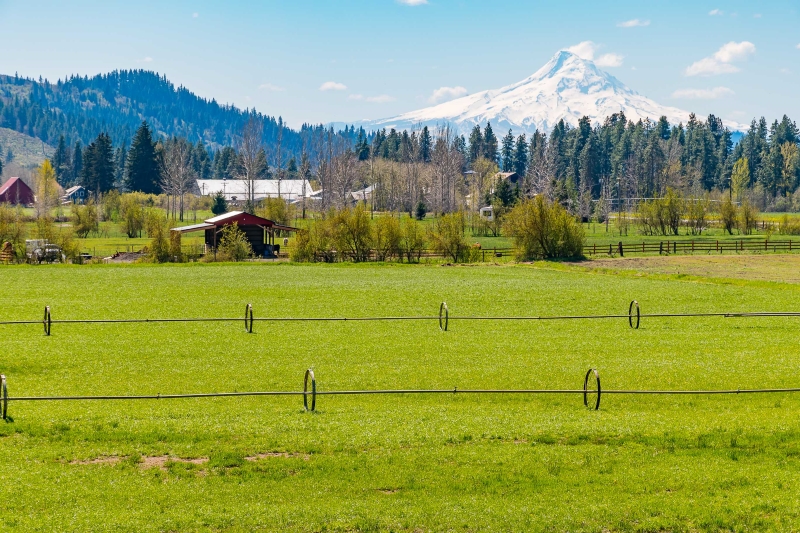Supporting productive farms and clean water – Washington State Department of Ecology (.gov)

Advancing Sustainable Development Goals through Agricultural Water Quality Guidance
Introduction
A significant milestone has been reached in a multi-year initiative to align agricultural productivity with environmental stewardship. The final chapters of the Voluntary Clean Water Guidance for Agriculture are now available for public review. This technical resource outlines Best Management Practices (BMPs) designed to support the simultaneous achievement of Sustainable Development Goal 6 (Clean Water and Sanitation) and Sustainable Development Goal 2 (Zero Hunger) by protecting water quality while ensuring the viability of productive farms across Washington.
Core Strategies for Sustainable Water and Land Management
The guidance focuses on key agricultural practices that directly contribute to several SDGs by controlling and treating nonpoint source pollution.
Aligning with SDG 6 (Clean Water) and SDG 15 (Life on Land)
- Minimizing Runoff and Preventing Erosion: Practices such as cover crops and contour farming are promoted to reduce surface runoff and protect topsoil from erosion, thereby safeguarding terrestrial ecosystems (SDG 15) and preventing sediment from entering waterways (SDG 6).
- Infiltrating Runoff and Intercepting Eroded Soil: Vegetative practices, including the use of filter strips, are recommended to reduce runoff velocity and trap sediment, further protecting aquatic habitats and contributing to SDG 14 (Life Below Water).
Promoting SDG 12 (Responsible Production) and SDG 2 (Zero Hunger)
- Managing Fertilizers and Pesticides: The guidance emphasizes the precise application of nutrients and pesticides to ensure responsible production patterns (SDG 12). This limits chemical transport to surface and groundwater, protecting water resources while supporting sustainable food production (SDG 2).
- Efficiently Applying Irrigation Water: Advanced irrigation management protects water quality by ensuring water is applied efficiently, reducing excess runoff that can carry pollutants. This practice supports sustainable water use within agriculture.
Integrated Water Resource Management (SDG 6.5)
- Controlling Surface and Subsurface Drainage: The guidance details methods for managing drainage to regulate water flow, reduce nutrient loss, and limit the transport of pollution. This represents an integrated approach to managing water resources at the farm level.
Collaborative Framework and Stakeholder Engagement (SDG 17)
Multi-Stakeholder Partnerships
The development of this guidance exemplifies SDG 17 (Partnerships for the Goals). The long-term effort involved extensive research and collaboration with advisory groups composed of diverse stakeholders to ensure the final product is technically sound and practical for implementation. Partners included:
- State agencies
- Conservation Districts
- Agricultural producer groups
- Environmental organizations
- Tribal representatives
Guidance Implementation and Support
The completed guidance will serve as a key tool for achieving water quality objectives in partnership with the agricultural community. Its primary uses include:
- Informing water cleanup plans and strategies.
- Providing consistent technical assistance and recommendations to landowners.
- Directing financial assistance and grant funding for implementation of BMPs.
- Shaping outreach and educational efforts to promote sustainable practices.
Public Consultation and Finalization Process
Chapters Available for Public Review
Public comment is being accepted on eight draft chapters and an additional section on manure lagoons within the Livestock Management chapter. The chapters under review are:
- Crop Systems
- Nutrient Management
- Pesticide Management
- Vegetative Sediment Control
- Irrigation Management
- Subsurface Drainage Management
- Runoff Control for Agriculture Facilities
- Suites of Practices
Key Dates and Engagement Opportunities
- Comment Period Deadline: Comments on all draft chapters will be accepted until 11:59 p.m. on November 21, 2025.
- Informational Webinar: A webinar will be hosted on November 5, 2025, at 10 a.m. to provide an overview of the practices covered and the development process.
Next Steps
Following the public comment period, a response to comments will be prepared, and necessary revisions will be made to the draft chapters. The final guidance chapters are scheduled for submission to the EPA by the end of the year, alongside the 2025 Nonpoint Plan update.
Analysis of SDGs, Targets, and Indicators
1. Which SDGs are addressed or connected to the issues highlighted in the article?
The article on the “Voluntary Clean Water Guidance for Agriculture” addresses several interconnected Sustainable Development Goals (SDGs) by focusing on the intersection of agricultural practices, environmental protection, and water resource management. The following SDGs are relevant:
- SDG 6: Clean Water and Sanitation: This is the most central SDG, as the entire purpose of the guidance is to “protect water quality” from agricultural nonpoint pollution.
- SDG 2: Zero Hunger: The guidance aims to achieve its environmental goals while ensuring the viability of farming, with a stated goal to “support both clean water and productive farms.” This connects directly to the sustainable agriculture aspect of SDG 2.
- SDG 14: Life Below Water: By preventing pollutants like fertilizers, pesticides, and sediment from entering surface waters, the guidance directly contributes to reducing land-based pollution that affects marine and coastal ecosystems.
- SDG 15: Life on Land: The article highlights practices such as using cover crops and contour farming to “preventing erosion” and protect soil, which is a core component of protecting terrestrial ecosystems and halting land degradation.
- SDG 12: Responsible Consumption and Production: The focus on efficient use of resources, such as “managing fertilizers and pesticides” and “efficiently applying irrigation water,” aligns with the principles of sustainable management and efficient use of natural resources.
- SDG 17: Partnerships for the Goals: The article emphasizes the “collaborative process” involving state agencies, agricultural groups, environmental organizations, and tribal representatives, which exemplifies the multi-stakeholder partnerships essential for achieving the SDGs.
2. What specific targets under those SDGs can be identified based on the article’s content?
Based on the specific actions and goals described in the article, the following SDG targets can be identified:
- Target 6.3: By 2030, improve water quality by reducing pollution. The article directly addresses this by outlining best management practices (BMPs) to “control and treat pollution” from agricultural sources, specifically mentioning the management of “nutrients (manure and chemical fertilizers) and pesticides” to limit their transport to surface and groundwater.
- Target 6.4: By 2030, substantially increase water-use efficiency across all sectors. The guidance chapter on “Irrigation Management” aims to protect water quality by “ensuring that water is applied efficiently and only when needed, reducing excess runoff.” This directly supports more efficient water use in the agricultural sector.
- Target 2.4: By 2030, ensure sustainable food production systems and implement resilient agricultural practices. The article promotes practices like “cover crops,” “contour farming,” and “filter strips” which are resilient agricultural practices designed to “protect soil from eroding” and maintain ecosystem health while supporting “productive farms.”
- Target 14.1: By 2030, prevent and significantly reduce marine pollution of all kinds, in particular from land-based activities, including nutrient pollution. The guidance is a direct effort to control “nonpoint pollution” from agriculture, which is a primary land-based source of the “nutrients, pesticides, and sediments” that pollute downstream water bodies and eventually marine environments.
- Target 15.3: By 2030, combat desertification, restore degraded land and soil… and strive to achieve a land degradation-neutral world. The article’s focus on “Minimizing runoff and preventing erosion” through practices like cover crops directly contributes to improving soil quality and preventing land degradation.
- Target 12.4: By 2020, achieve the environmentally sound management of chemicals and all wastes. The guidance on “Nutrient Management” and “Pesticide Management,” which ensures chemicals are “applied in the right amount, at the right time, and in the right place,” is a clear example of promoting the environmentally sound management of agricultural chemicals to minimize their release into the environment.
- Target 17.17: Encourage and promote effective public, public-private and civil society partnerships. The development of the guidance is described as a “long-term effort involving… partner engagement” with “advisory groups made up of representatives from: State agencies, Conservation Districts, Agricultural producer groups, Environmental organizations, [and] Tribal representatives.” This multi-stakeholder collaboration is a model for this target.
3. Are there any indicators mentioned or implied in the article that can be used to measure progress towards the identified targets?
The article does not mention official, quantitative SDG indicators. However, it implies several qualitative and activity-based indicators that could be used to measure progress:
- Adoption of Best Management Practices (BMPs): The core of the guidance is a set of BMPs. Progress can be measured by the rate at which agricultural producers adopt the practices outlined in the guidance chapters, such as “Crop Systems,” “Nutrient Management,” and “Irrigation Management.” This would serve as a proxy indicator for Targets 6.3, 2.4, and 12.4.
- Reduction in Pollutant Runoff: The article’s goal is to limit “chemicals and nutrients that can be transported to surface waters or groundwater.” An implied indicator is the measured reduction of specific pollutants (e.g., nitrogen, phosphorus, pesticides, sediment) in water bodies adjacent to agricultural lands. This directly relates to measuring progress for Targets 6.3 and 14.1.
- Area of Land Under Sustainable Management: The implementation of practices like “cover crops,” “contour farming,” and “vegetative filter strips” can be measured by the total acreage on which they are applied. This provides a tangible indicator for progress towards Targets 2.4 and 15.3.
- Functioning of Multi-Stakeholder Partnerships: The existence and continued engagement of the “advisory groups” with diverse representation is an indicator of a successful partnership (Target 17.17). The completion and submission of the guidance chapters to the EPA is a measurable outcome of this partnership.
- Development and Implementation of Water Cleanup Plans: The article states that the guidance is used to “inform water cleanup plans and strategies.” An indicator of progress would be the number of water cleanup plans developed and implemented that incorporate the recommendations from this guidance. This relates to Target 6.3.
4. Summary Table of SDGs, Targets, and Indicators
| SDGs | Targets | Indicators (Implied from the Article) |
|---|---|---|
| SDG 6: Clean Water and Sanitation | 6.3: Improve water quality by reducing pollution. | Measured reduction in nutrient, pesticide, and sediment concentrations in surface and groundwater. |
| SDG 2: Zero Hunger | 2.4: Ensure sustainable food production systems and implement resilient agricultural practices. | Area of agricultural land managed with sustainable practices (e.g., cover crops, contour farming). |
| SDG 14: Life Below Water | 14.1: Prevent and reduce marine pollution from land-based activities, including nutrient pollution. | Reduction in the load of agricultural nonpoint source pollutants (nutrients, sediments) entering waterways. |
| SDG 15: Life on Land | 15.3: Combat desertification and restore degraded land and soil. | Reduction in soil erosion rates on agricultural lands. |
| SDG 12: Responsible Consumption and Production | 12.4: Achieve the environmentally sound management of chemicals. | Adoption rate of guidance for precise application of fertilizers and pesticides. |
| SDG 17: Partnerships for the Goals | 17.17: Encourage and promote effective multi-stakeholder partnerships. | Number and diversity of stakeholders (agencies, producers, environmental groups, tribes) actively engaged in the guidance development and implementation process. |
Source: ecology.wa.gov
What is Your Reaction?
 Like
0
Like
0
 Dislike
0
Dislike
0
 Love
0
Love
0
 Funny
0
Funny
0
 Angry
0
Angry
0
 Sad
0
Sad
0
 Wow
0
Wow
0
















































/environment-climate-change-and-health-(ech)/water-sanitation-hygiene-and-health-(wsh)/landfill-tuvalu-36092.tmb-1200v.jpg?sfvrsn=5c21fe40_1#)

.jpg.webp?itok=0ZsAnae9#)
























